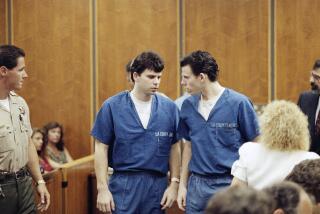Rulings on jail terms inconsistent after changes to three-strikes law
After nearly two decades behind bars, Mark Anthony White saw a chance for freedom last year when California voters softened the state’s tough three-strikes law.
Within weeks of the election, White asked a judge to reduce his 25-years-to-life sentence under the ballot measure, which allows most inmates serving life terms for relatively minor third strikes to seek more lenient sentences.
White would have walked free if his request had been granted. But a San Diego County judge refused to reduce White’s sentence. The judge ruled that the 54-year-old prisoner’s last crime, being a felon in possession of a firearm, made him ineligible for a lighter punishment.
A year after state voters overwhelmingly approved Proposition 36, judges around the state are handing down conflicting decisions on whether prisoners given life terms for gun possession can qualify for shorter sentences.
The ballot measure specifically excluded prisoners whose third strikes were either violent or serious, or who during the commission of their last crime were armed with a firearm or deadly weapon.
Whether someone convicted of simply possessing a firearm was in fact armed during the commission of a crime is a more complicated legal question than it might appear. The answer could mean the difference between freedom and life in prison for more than 280 third-strikers across the state. In Los Angeles County, about 120 prisoners are waiting for the legal wrangling over the issue to be resolved.
White has appealed the decision denying his request for a shorter sentence, and his case appears to be the first in which an appeals court could address the issue head on.
In Los Angeles, Superior Court Judge William C. Ryan, who is handling all of the county’s resentencing requests, said he is waiting to make a decision in his cases until a three-judge panel of the state’s fourth appellate district issues an opinion in White’s appeal.
“This is a legal issue that will get settled, and we can then move these cases forward,” Ryan said.
While possessing a firearm is legal for most people, convicted felons are not allowed to have firearms under California law, and being caught with a gun is a felony.
Mike Reynolds, whose daughter’s 1992 murder led him to spearhead the creation of the three-strikes law, said he fears Proposition 36 will allow prisoners with such third strikes to obtain reduced sentences.
“The vast majority of people would agree that [White] is the kind of guy who does not deserve to be on the streets,” said Reynolds, who campaigned against last year’s reform initiative.
But attorney Michael Romano, who helped write the ballot measure, noted that White will not automatically win release if the courts decide that prisoners like him are eligible to ask for shorter sentences under Proposition 36. The initiative requires judges to evaluate every third-striker who asks to be resentenced and reject requests from anyone who poses an unreasonable risk of danger to public safety.
Romano said the courts should not exclude prisoners based only on the fact that their third strikes were for firearms possession.
“If they’re not a threat to public safety, they should be released,” said Romano, who heads Stanford Law School’s Three Strikes Project.
In Kern County, Deputy Public Defender Amanda Moceri said, two judges rejected requests to resentence prisoners serving life sentences under three-strikes for simple gun possession. But a third judge ruled last month in favor of one of Moceri’s clients.
Moceri argued that being in possession of a firearm is not necessarily the same as being armed. Keeping a firearm in storage, for example, or giving a gun to a friend for safekeeping can be considered weapon possession. To be considered legally armed, however, someone must have a weapon readily available while committing another type of crime, such as theft or assault, Moceri said.
The lawyer successfully argued that although a jury found her client Rumaldo Barboza guilty of possessing a firearm, jurors were never asked to decide whether he was legally armed. The judge agreed and, after concluding that Barboza was not a danger to the public, reduced his 25-years-to-life sentence to six years, Moceri said.
A judge in Santa Clara County made a similar ruling in June, concluding that being a felon in possession of a firearm is not enough to disqualify a third-striker from a shorter sentence under Proposition 36.
In White’s case, however, San Diego County Superior Court Judge David J. Danielsen concluded that felons caught with firearms were the sort of dangerous offenders Proposition 36 meant to keep behind bars.
Prosecutors described White as a member of the Hell’s Angels motorcycle gang. On March 29, 1995, El Cajon police went to his home after an informant reported seeing White transport a large amount of methamphetamine, according to court records.
Police said they saw White holding an object under a cloth as he walked to his truck. After seeing the officers, White ran and threw the object into his truck, police said. They said they recovered a loaded Taurus .357 revolver. White’s previous convictions included three separate strikes: robbery, burglary and assault with a deadly weapon on a police officer.
At a special appeals hearing in White’s case this month at Brawley Union High School, Deputy Atty. Gen. Warren Williams argued that offenders convicted of gun possession should be excluded from Proposition 36 if judges determine that the weapon was on them or immediately available to them at the time of the crime.
White’s lawyer said his client insisted he was no longer a member of the Hell’s Angels when he was arrested and had the gun to protect himself from the gang, which had threatened him. Attorney Richard Jay Moller argued that judges should be given the chance to decide whether third-strikers like White — whom he described as a model inmate — pose a danger to the public today and release those who do not.
A decision in White’s case is expected within three months.
More to Read
Sign up for Essential California
The most important California stories and recommendations in your inbox every morning.
You may occasionally receive promotional content from the Los Angeles Times.











